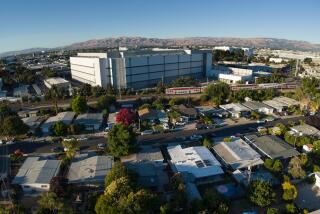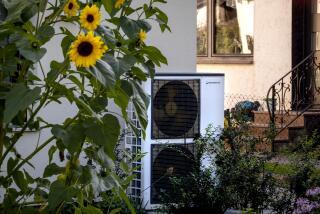Navy Sheds Light on Power Use
- Share via
On a Seabee base dominated by squat yellow buildings out of the 1960s sits one with white-sloped roofs, a recycled water system, and photovoltaic cells that seems right for the present.
As Southern California hurtles into a summer of energy woes, this unique building at the Port Hueneme naval base is getting the attention its makers had always hoped it would receive.
As the Navy’s sole energy showcase building, it is one of only a few working office buildings in the country that heats itself, cools itself, lights itself, and sends electricity it doesn’t need back to the power grid.
“It’s great seeing all the attention we’re finally getting,” said Richard Spiessl, engineering support manager for Naval Base Ventura County, and one of the shepherds of the project.
And all it took was an energy crisis.
This month will see the building’s first open house, as Navy personnel from throughout the country arrive to visit an office that could be the model for the environmental building of the immediate future. Also, the Navy is applying to the U.S. Green Building Council to make the structure one of only two buildings to receive the group’s highest ranking for environmental sustainability.
And the Navy and Southern California Edison are about to kick off a study that will tell its designers exactly what their building has achieved, and has yet to achieve.
Its designers have incorporated the latest technology to make the building--renovated at a cost of $3 million--as energy-efficient as possible.
That means innovations as simple as white sloping roofs and well-positioned windows to reflect light into the building, making any man-made lighting unnecessary during daylight hours.
It also means solar-heated water to keep the building warm in the winter and hot water for sinks and showers. It means the use of recycled materials, down to squares of carpeting made from plastic. And native landscaping that requires no maintenance, with drainage systems that keep water on the site and do not let it flow as dirty runoff into the ocean.
And it can be as complicated as the photovoltaic cells on the roof--the silicon wafers that turn the sun’s rays directly into electricity--and heating and cooling systems that can read the air and carbon dioxide levels, and are programmed for the appropriate response.
It also means some innovations that may be a bit ahead of their time, such as a natural gas heat pump to heat and cool one of three conference rooms.
And it has meant that the 70 people who work there as part of the base’s Public Works Department have had to learn to adjust to a business environment without the familiar blast of fluorescent lights.
“People thought, ‘I need the lights on to work, I get a headache,’ ” said Bob Wood, director of public works. “Now, if they come in at 8 a.m. and the lights are on, it bothers them.”
All of the pieces of the building are available on the market, but builders have been slow to pick up on them, said Stephen Selkowitz, head of building technologies at Lawrence Berkeley National Lab at UC Berkeley. And until that happens, they will very likely remain expensive.
“Building owners have the approach of trying to minimize the first cost without thinking of energy costs downstream,” he said. “They need to think in a life-cycle perspective.”
Items such as photovoltaic cells, which Selkowitz said are hardly used now, are the type of tools that pay off 10 to 15 years down the road. But, sustainability--especially in light of the energy crisis--is a hot topic in discussion, if not action.
More to Read
Inside the business of entertainment
The Wide Shot brings you news, analysis and insights on everything from streaming wars to production — and what it all means for the future.
You may occasionally receive promotional content from the Los Angeles Times.










